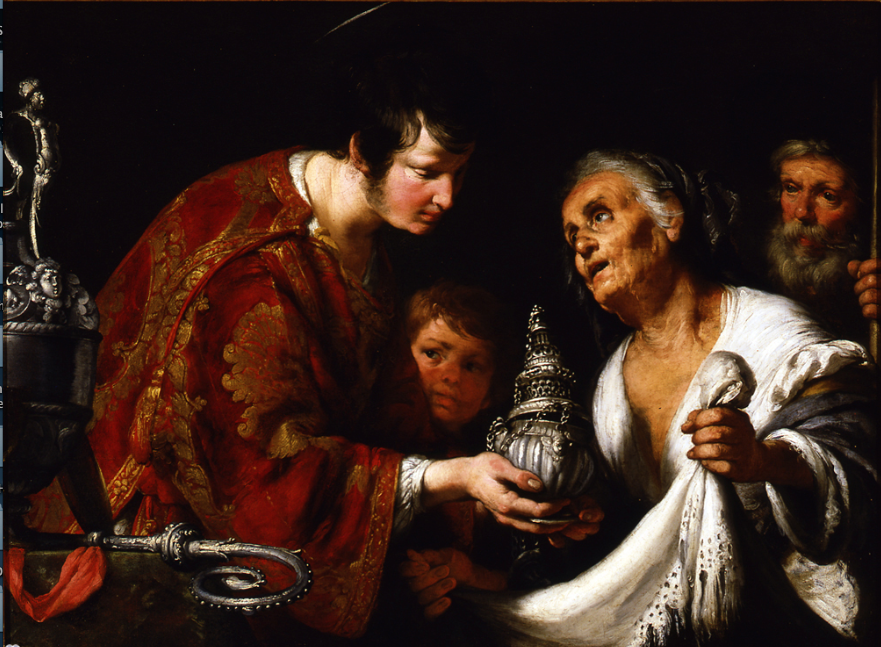
*
Art Scatter lives! We admit, we’ve been remiss. We haven’t filed a post since July 28 of 2012, for heaven’s sake. That’s 10 months. Our last post was about the demise of the fabled Classical Millennium music shop (which, we’re happy to report, lives on, if in extremely truncated form, inside its big-daddy Music Millennium) and that sort of depressed us. Plus, we got busy with other things, not least of which was posting quite a bit on Oregon ArtsWatch, and also conducting a little daily art-historical experiment called “Today I Am” on Facebook. It was partly through that endeavor that Carol Shults of the European and American Art Council of the Portland Art Museum asked me if I might give a gallery talk to the group: just pick any topic as long as it relates to those galleries, she said.
So I did. My talk, called “The Way of All Flesh” (thanks, Sam Butler), took place last Thursday in the museum’s Renaissance gallery, with just a peek around the corner into the Baroque. It covered eight paintings, with quick swipes at a few others, ranging from 1500 to roughly 1640. And it was fun, even if I rambled a bit too freely and didn’t quite cover everything I’d expected to. When you’re in the galleries, looking at the actual works instead of looking at slides of them in a lecture hall, you tend to toss away your notes and just talk. What follows is the more or less formal speech I didn’t give, but which formed the basis of my more conversational remarks in the galleries.
All of the pictures, by the way, are gathered from the museum’s relatively new and growing online photo gallery of works from the permanent collections. It’s a great project; check it out when you can. – BH
*
By BOB HICKS
The title of my talk is “The Way of All Flesh.” I’m sorry if you came thinking I was going to do a slide show about nude bicyclists pumping through Puddletown. Not gonna happen. Instead I’m going to talk about the ways we’ve looked in Western civilization at life and decay and death. That’s not really the bummer it might sound like, because in the process we get to look at a handful of pretty fascinating paintings covering a little over a century, between about 1500 and roughly 1635 or 1640.
The subtitle is “Purity, Pain, and Pragmatism from Caroto to Van Dyck.” If I hadn’t submitted it before I’d finished my research, I’d have changed it to “from Botticelli to Van Dyck,” because Botticelli’s small painted devotional “Christ on the Cross,” which really starts things off, is from 1500, ten years before Caroto’s intimate painting “The Entombment of Christ.” I figure that’s a good mistake, because anytime you can kick off an evening by looking at a Botticelli, you’ve got a fighting chance.
We’ll dive into the paintings pretty soon. But first I think a little background is a good idea. The earliest of these paintings come from a time when the Renaissance was still keeping a foot, or at least a few toes, in the reassuring soil of the Middle Ages. The most recent was painted when Europe had planted its feet solidly at the beginnings of the modern age. Historians actually call this entire span part of the Early Modern Period, which they generally date from about 1500 to about 1800.
But history almost never moves forward in neat unison steps. The first three paintings we’ll be looking at seem very much steeped in leftover beliefs and customs from late medieval times. The later paintings strike me as being within easy shouting distance of the Enlightenment and what we lay people tend to mean when we talk about the dawning of modernism.
When Botticelli created his Christ figure in 1500 it was only eight years after Columbus’s first voyage westward. It was eight years after the expulsion of Jews and Muslims from Iberia. It was nine years after the beginning of the Spanish Inquisition. Rumblings against the power of the Roman Church had been stirring for some time. But Martin Luther wouldn’t post his 95 Theses for another 17 years.
By the time of Anthony Van Dyck’s portrait of Cardinal Rivarola, in 1623 or ’24, the Reformation and the Thirty Years’ Wars were in full swing, and the continent was openly challenging the Roman Church’s position as the ultimate arbiter of European life and thought. Science was on the march. Poverty and illiteracy were still common, but the cultural climate across the continent had changed remarkably. The great literary revolutionary William Shakespeare had died less than 10 years before. The so-called “New World” had been irreversibly overtaken by European settlers. The colonies had become a familiar topic of discussion and even investment among educated Europeans – an economic treasure-chest that was changing the way the European world thought about trade and material progress and even government and basic human rights.
What I’d like to trace is just a little bit about the movement from a doctrinaire religious perspective over these years to a more open, sectarian society. By the time we finish, religious institutions are still a dominating cultural force. But they’re beginning to take a more practical, worldly turn. In these paintings we’ll be able to see a gradual but significant shift. And it’s not just in the ways artists approach the human body, but also in the ways they think about what the body means. We’ll see these pictures moving from pious or fearful ponderings of the eternal to a far more pragmatic concentration on the here and now.
*
So what do I know about all this? I’m not a curator. I’m not an art historian. I’m not a historian at all. I’m also not a working artist, except in words. I’m a journalist, and I’ve spent most of my career writing about various aspects of the arts, including visual art. Being a journalist means you learn how to cherry-pick what other people know and put it into perspective. You learn to connect the dots. Sometimes you draw the lines from the wrong dot to the wrong dot, and then somebody corrects you, because there’s always someone who knows more about the subject you’re writing about than you do. If you’re smart, you talk to that person, those people, first. Over the years I’ve written a fair amount about this museum, at one time or another about pretty much all of its collections. I’ve also written about a lot of its special exhibitions, from Stroganoff to Hesse to Thomas Moran and Titian’s “La Bella,” and even fancy automobiles, which at the beginning I knew next to nothing about. The trick is to do your homework and then explain things as clearly as you can.
My friend Carol Shults, who as you know is an active member of the European and American Art Council, invited me to give this evening’s talk. I think she asked me at least partly because of a quirky little project I’ve undertaken on Facebook, called Today I Am. Every day for more than a year I’ve posted a picture of a painting or another work from art history and written a very short story to go with it. In the little stories I imagine myself as one of the characters inside the artwork. I’ve been Greek heroes, gods, demons, saints, sinners, monsters, monks, women of prowess, ladies of leisure, drunkards, politicians, even forces of nature and beasts of the field. This morning I was some sort of odd, pale, floating spirit-sister, seeding the dreams of a sleeping traveler below. It’s actually quite fun, and it’s allowed me to take a stirring stroll through the gardens of art history.
So naturally when Carol asked me if I’d give a talk, I thought of personalities and portraits, and began to put together a few ideas before deciding to take a different tack. The talk I could have given about portraits in the museum’s collection would have followed a very different path. For one thing, it would have started at the opposite end of these galleries. But it would have ended at the same place, in front of Van Dyck’s dazzling portrait of Cardinal Domenico Rivarola, which is truly one of the great pieces this museum possesses.
Portraits, of course, undertake a different task from dramatic or religious paintings. They are studies of rank, privilege, character, social situation, ideas of beauty. At their most ambitious, they’re efforts to detect the nature of a soul. And they’re usually commissioned either by the sitter or someone with a vested interest in pleasing the sitter. That means they have to strike a sometimes difficult balance between flattery and honesty. At their best, they can manage both. But it’s a tricky business. Maybe the most famous example of gilding the lily is Hans Holbein the Younger’s painting of the German lady Anne of Cleves, who became the fourth wife of England’s King Henry the Eighth. Holbein painted her so attractively that, according to legend, the king, who had never actually met or seen her, agreed to marry her. But when she showed up in the flesh he was not nearly so smitten. The marriage lasted just six months before it was annulled, at least officially unconsummated. Anne received a nice settlement, was referred to thereafter as “The King’s Beloved Sister,” and Holbein, maybe surprisingly, retained his favor as a court painter.
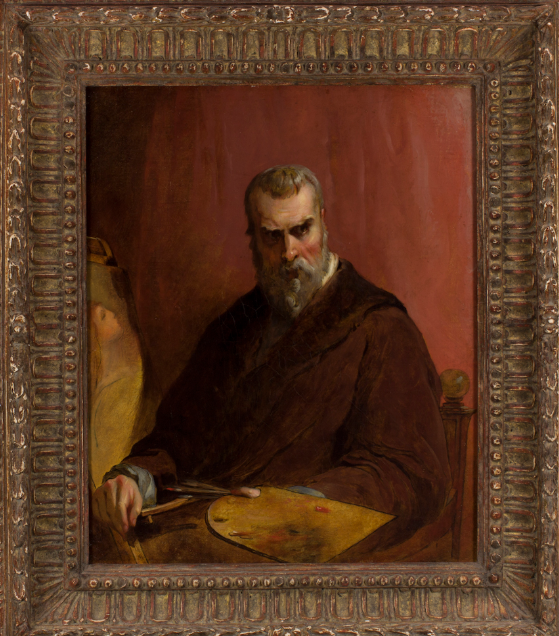
*
For this talk that we’re not having I’d chosen a few likely prospects. When you have a chance to roam the galleries a bit you might like to give them a fresh look.
We would have looked at Nicolas de Largilliere’s 1714 “Portrait of Prince Christian of Bavaria,” a painting that reveals a solid, comfortable, let’s say beefy, Chateaubriand of a man, with a curling wig, a fine forehead, and kind eyes. We’d have seen Honore Fragonard’s little twin lovelies of genre portraiture, “Girl with a Marmot” and “Boy with a Peep Show,” both from 1780. They’re a bit like 18th century Norman Rockwells, and I actually mean that as a compliment to both artists.
We’d have looked at Jean-Simon Barthelemy’s fine and probing 1802 painting “Portrait of an Artist,” very likely of Hubert Robert, a painter of moody architectural ruins, and a man with sharp and sideways eyes. And we’d have seen one of my favorite likenesses in the collection, Jerome Martin Longois the Younger’s 1831 “Portrait of the Comte de. M.” The count is painted in dark grays and browns, with vivid flesh tones, a little like a Goya. He’s a man of character and responsibility and a certain sadness in his eyes.
We’d take a look at Sir William Beechey’s 1815 “Portrait of Mrs. Kingsford,” a young society beauty, composed and serene. And we’d glance at another, much more idealized, beauty, on temporary loan from a British collector, Sir John Everett Millais’ 1865 “Joan of Arc,” with her gorgeous armor and uplifted Pre-Raphaelite fairy-tale face.
We would hover for much more than a moment before the smallish, wolfish, remarkable “Study for Tintoretto Painting His Dead Daughter,”the French painter Leon Cogniet’s 1843 depiction of a scene from 1590, when a distraught Tintoretto did, indeed, paint a likeness of his daughter as she lay awaiting burial. You can miss this painting on a busy side wall in the far gallery on this floor, but you really should seek it out. The combination of grief and compulsion is compelling. So is the rigid set of the artist’s jaw, which seems to echo the rigid set of his daughter’s body. It’s a moment of startling passion, and compassion, reimagined after 250 years.
And we might walk discreetly past Courbet’s large and dark and patched-together 1847 painting “The Violincellist,” a prize of the museum’s collection, but one whose charms, I’m unhappy to confess, continue to elude me.
*
But enough about the talk we’re not going to have. Let’s get down to the one we are.
One of the advantages of an assignment like this is that it’s encouraged me to look freshly at paintings I’ve known casually sometimes for 30 years and more. I’ve often walked past them with barely a second look.
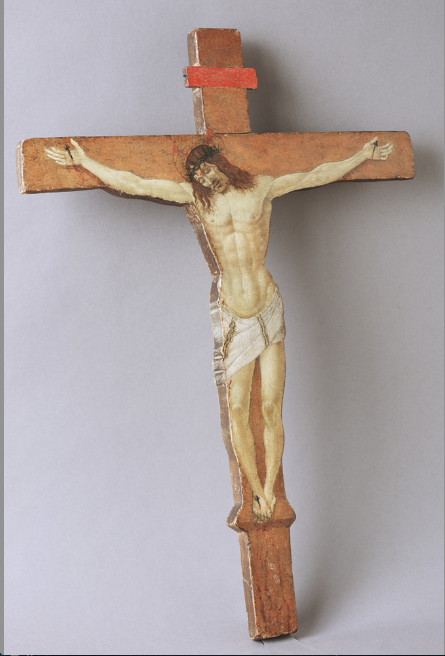
Sandro Botticelli’s 1500 “Christ on the Cross” is a prime example. I think of Botticelli for his big, lush, startlingly crisp and beautiful mythological paintings. This small piece, part painting and part sculpture, is painted in tempera on a devotional-sized wooden cross. What! I’ve thought, several times as I’ve scurried past on my way to something else. This heavy medieval-feeling thing from the great creator of Venus on the Half-Shell and “The Allegory of Spring”? That wide-open, astonishing mind, shut down to a symbol of piousness?
To tell you the truth, the piece has almost offended me. It’s seemed like going to a ball game to see Felix Hernandez pitch and watching him get whacked for seven runs in the first inning and then head for the showers. Then I looked again, maybe for the first time, really, and saw the turn of Jesus’ legs at the knee, the supple lines of muscle, the droop of the head and the quietude in his closed eyes, and I thought, yes, this is an artist. No medieval hack could have done this.
Botticelli was under the influence of the puritanical zealot Savonarola at the time, and although there isn’t indisputable proof, he’s said to have tossed some of his great mythological paintings onto one of the preacher’s Bonfires of the Vanities, those infamous flames that devoured beautiful objects deemed vain or profane. There’s no question that Botticelli’s association with Savonarola harmed his art. It quite probably harmed his thinking, too. But it couldn’t extinguish his artistry. Maybe we shouldn’t be asking, “How could Botticelli have done this?” but observing, “Botticelli did this.” He was an artistic genius. He was also a creature of his times.
This painting’s existence here in this Portland gallery is a potent reminder of the powerful influence that not just the Church but also religious belief in general exerted over both the common people and many of the finest minds of the time. I will add that Savonarola’s zealous spirit is alive and kicking and playing with fire in our not so modern world. In Afghanistan, Taliban warriors have destroyed great ancient Buddha statues that had stood for at least 700 years. It wasn’t a mistake during wartime. It was calculated destruction of an idea deemed offensive. In Syria, vital archaeological and artistic sites have been turned to rubble by warring factions. I have little doubt that some of the more demon-ridden inhabitants of our American pulpits and airwaves wouldn’t mind lighting a match to a little art, themselves, if they thought they could get away with it.
*
Let’s turn now to this small painting from 1517. “The Circumcision of Christ” is by Jacob Cornelisz Van Oostsanen, who was one of the first prominent artists in Amsterdam. The title tells you pretty much what’s going on. We’re cutting flesh here. It’s very much about Jesus undergoing the physical burdens of being a human being. He can’t redeem creatures made of flesh if he doesn’t experience what it means to be made of flesh first. The painting has an odd bird’s-eye viewpoint at the center. The doctors and helpers look foreshortened as they’re operating on a none too happy Christ child, who also, curiously, appears to have a flattened forehead. It’s very forward-thinking. Foreshortened, foreheaded, foreskinned. And as your eye goes up to the rest of the painting, the perspective becomes more straightforward.
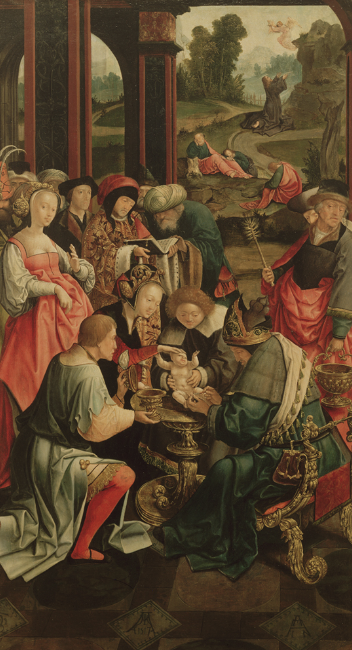
But what’s really interesting for our purposes here is what’s going on in the background. Look at the angel hovering over a suffering adult Jesus as he kneels on the ground in the Garden of Gethsemane, in the throes of his Agony. Jesus’ betrayal and arrest are imminent, and he knows it. Soon he’ll be hanging on that cross that so fascinated and obsessed Botticelli.
This is a time-bending painting. It shifts events far removed chronologically into a single pictorial moment. This is partly, I think, because the story of Christ was looked on as a unity. And it’s partly because, in 1517, Europe was still a largely illiterate society. In cultures without a lot of literacy, paintings were called upon to depict familiar narrative arcs from oral storytelling.
I like to think this multiple imaging also anticipates, I imagine unknowingly, our own sense of a relative universe in which time as well as matter is movable and subject to alteration. Einstein’s astral traveler moving at the speed of light can return to Earth still a young man while everyone who stayed behind has become old. Time can overlap in the same space. It also strikes me that Van Oostsanen’s painting gives pictorially literalized witness to the belief that one’s past thoughts and actions are always part of one’s present. They hover. And, in the medieval understanding of the human condition, without Jesus’ intercession they soil all possibilities. As the text says, “Be sure. Your sin will find you out.” There were a LOT of sins to be found out. Of course they will be. They’re right there. That sense of omnipresence, of being bound and dragged down by one’s thoughts and deeds no matter how fugitive or far in the past, also helps to explain why, in the cosmology of the time, only Christ’s great sacrifice is substantial enough to save us from our sinful selves. It’s a huge, scary message, and there it is, in the painting, made vivid for even the illiterate to understand. The baby Jesus, being circumcised: This is my body, bleeding for you. The adult Jesus, about to be nailed to the cross: This is my body, bleeding for you.
*
Now, at last, let’s move on to the Caroto, from seven years before the Van Oostsanen and ten years after the Botticelli. In other words, in the days before mass communication, practically the same moment. Giovanni Francesco Caroto’s painting “The Entombment of Christ,” from 1510, is smaller than “The Circumcision of Christ,” and in a weird way it seems friendlier, maybe because of its sunny, vibrant colors. But it illustrates the same point. In the main frame, Christ is being laid into his tomb by his disciples while his mother, presumably, falls into a dead faint. In the background, separated in space, are three other out-of-time scenes from the Good Narrative. The crosses on Calvary Hill. The fishing boat on the water where the miraculous draft of fishes was hauled in. The bolting horse that’s just tossed the soon-to-be apostle Paul as he’s been struck blind on the road to Damascus. Beneath the crosses, in yet another time warp, the fourth-century St. Jerome, translator of the holy texts into Latin, kneels before the spot of the great and terrible and wonderful mystery.

In this trio of paintings – Botticelli, Van Oostsanen, Caroto – flesh is vividly a burden and a ritual. Remember, these artists were working in a time and place where life spans were brutally short, and biological catastrophes with scary names like the Black Death periodically thinned the human herd. Their paintings are suffused with images of mortality and decay. Life is short, and then you die. Even God died, as the paintings make clear, so you can live again.
The Caroto and Van Oostsanen in particular don’t represent the most sophisticated art of their time. Compared to the giants of their contemporary art world they’re throwbacks, both stylistically and in their world views. For perspective, Leonardo da Vinci lived until 1519, two years after Van Oostsanen painted his medieval-feeling scene of Jesus’ circumcision. Michelangelo was born in 1475 and was already working as a painter for Lorenzo de Medici by the time he was 14. He lived all the way to 1564.
*

In spite of all those heavy Christian images, flesh didn’t always hang like an albatross around the necks of the era’s painters. Let’s glance quickly at this painting from 1521 by Giampietrino, also known as Giovanni Pietro Rizzoli. His paintings were nominally and often explicitly religious. But he also had a way, at a relatively early date, of approaching his subjects as real people rather than ritualistic symbols. This painting is a portrait of “St. Mary Magdalene.” But it could be a portrait of just about anyone – or just about anyone who looked vaguely like someone in a Leonardo painting. Giampietrino was a pupil of Leonardo, and you can see it in the olive curves of the Magdalene’s face and even her mysteriously disappearing, sort-of Giaconda smile. The pupil’s not the master. Still, it’s nice to see some flesh being celebrated for being healthy and alive.
*
Now we come to a pair of Mother and Child paintings from just a few years later. Both have moved beyond the death-cult paintings where we began, and on to images of daily life, even if the daily life is that of a blessed virgin and a child who is also a god. But although the subjects of the two paintings are the same, the evocations of their fleshliness are strikingly different.
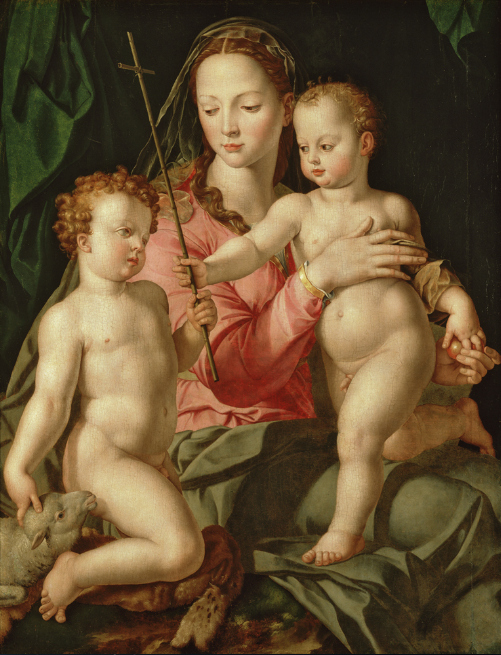
Here, on the right, and painted sometime between 1540 and 1560, is “Madonna and Child with the Infant St. John.” It’s by the Florentine Mannerist artist Bronzino, also known as Agnolo di Cosimo. This is really a lovely painting. It’s gorgeously balanced and lighted to show off that crystalline, porcelain skin, an ideal of human beauty. It actually takes its cues not directly from studio models but from previous art. Mannerism was a kind of early art about art, deeply influenced by the work of Michelangelo. It intrigues me that in some ways, in particular its stylized artificiality, Bronzino’s painting is a bit like the work of the Pre-Raphaelites of the latter 19th century. The affinity might seem odd, because the Pre-Raphaelites roundly rejected the approach of the Mannerists and their models, Raphael and Michelangelo. They looked for inspiration instead to the purity and clarity of line of the slightly earlier Italian Quattrocento artists, among them Leonardo and our religiously haunted friend Botticelli. Things do get muddled up around this time.
In this painting, Mary’s face is a perfect oval – again, an ideal of beauty. She’s the vessel of all that’s good in humankind. That’s why God chose her for this unlikeliest of miracles. The painting’s fraught with symbols – it may be art about art, but it’s also art meant to buttress beliefs. Or at least, it’s adopting the symbolic conventions of art that’s meant to buttress beliefs, whether that’s really what the artist is up to or not. The strangely twisting John proffers a small cross to Jesus, who accepts it sadly, his eyes rolled back in his head so he’s gazing Heavenward, knowing even as an infant that this is his destiny and it’s not gonna be fun. There’s no conclusive evidence that John and Jesus knew each other as children, though their meeting as adults as related in the gospels was important. They were second cousins, but not necessarily close. When John baptized Jesus he’s reported to have said, “I did not know him,” and people have been arguing about what he meant by that ever since. Whatever the truth might be, artists loved to put the cousins together as children, implying a pre-ordained common fate. It’s as if a 20th century artist had created a scene of Baby Mao and Baby Nixon dandling on one of their mothers’ knees. The Bronzino figures may be beautiful. But once again, they ain’t real, any more than that howling flat-headed kid being circumcised in the Van Oostsanen.
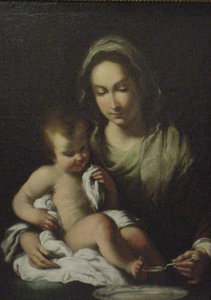
Now let’s look next door at Bernardo Strozzi’s “Madonna della Pappa.” It’s undated, but it’s from sometime in the first half of the 17th century. Strozzi was born in Genoa in 1581, and died in 1644, so we can guess this painting came no more than 80 to at most 100 years after the Bronzino, which means we’ve entered the Baroque. I like Strozzi quite a bit. I think he’s one of the more underrated painters in the museum’s collection.
Here we see, in roughly a century’s time, a shift from Bronzino’s high Mannerism to a softer and vastly more individualized beauty. This is still a devotional painting. It’s meant to suggest the depth of love of holy mother for holier child. But this Mary, though beautiful, is also particularized. Look at the long nose, the somewhat thin lips, even the slightly soiled, close-clipped nails on her fingers, which are rough from daily work, as she ladles soup for her son. When you begin to emphasize the particular you are taking a step away from the symbolic and the heavenly, and a step toward the real and the immediate. You can imagine the artist going into the market in search of a likely model. This Jesus is neither saint nor symbol. He’s a real kid, a bit on the chunky side. And unlike that wise and burdened baby Jesus in the Bronzino, who seems so dreadfully aware of the fate awaiting him, he’s not thinking about eternity. He’s thinking about this moment, and that soup, and how it’s going to taste on his tongue and feel on its journey down into his belly. He’s quite looking forward to this extremely human sensation. Because in addition to being God, of course, he’s also completely human. The Story doesn’t work if he’s not.
*
To finish our little journey of the flesh we need to move just around the corner, into the very beginning of the central Baroque gallery. We’ll walk past the bawdy and extremely fleshy mythology of Luca Giordano’s Cinemascopic “Battle of the Lapiths and Centaurs,” which I like quite a bit. And we’ll take a quick look at another Strozzi that I find even more interesting than the Madonna and Child. This one is “St. Lawrence Giving the Treasures of the Church to the Poor.” Again, it isn’t precisely dated. But it’s been narrowed down to sometime between 1635 and 1640, relatively late in his life and career.

For our purposes, and I have to say for personal reasons as well, I like Strozzi’s choosing of this scene. He painted it in several variations, including one at the Church of San Nicolo da Tolentino in Venice. I’ve seen that one only in reproduction, but I like Portland’s version better. In the scene, St. Lawrence, a 4th century martyr, is giving away the wealth of the Church rather than allowing it to fall into the hands of the Roman Emperor Valerian, who’s been busy putting Christians to death. Valerian also has an itching for the young Church’s not inconsiderable stockpile of wealth.
Lawrence looks suitably saint-like and humble here. But the painting’s focus is really on the old woman, grasping at the lace and reaching for the silver. She seems suspicious of the whole deal, but isn’t about to say “no.” By the time of this painting we’ve left ritual and stylization almost completely behind, and we’ve entered a sort of realism that seems harvested from the streets. You can imagine the old woman saying shrewdly, “How about food and shelter? That’s what we really need.” But she takes what she can get. She won’t use the lace or silver. But maybe she can sell them in the market, or trade them for food. The faces of the boy and man peering from the shadows are similarly complex: no joy or gratefulness to their benefactor, and yet a realization that this moment is beyond astonishing.
The painting also seems to signify a climbing down by the Church from its pinnacle of ritual and devotion and social control, and an involvement in the world around it. You can argue about whether that’s an accurate assessment of the state of the Church in 17th century Italy. But it’s certainly implied in the painting. This is religion as social justice. It’s God as a verb, not as a noun. It’s a focus on how we live, not on how we worship, which ends up being a better form of worship, after all. Things are changing.
*
And that brings us, finally, to this wonderful, shining painting by the young Anthony Van Dyck of the Cardinal Domenico Rivarola. Again, it’s the painting that also would have wrapped things up if we’d made this talk about portraiture. Van Dyck was born in Antwerp, where he was a prize pupil of Rubens and a fast friend of Jan Brueghel the Younger. He was 23 or 24 years old and immersing himself in the art of Italy, when he painted this portrait in 1623 or ’24. He’d already been in England briefly. But he hadn’t yet moved there permanently and become that country’s most important court painter, following in the tradition of Hans Holbein the Younger, in Henry the Eighth’s time.
Times have changed, slowly but significantly, since Botticelli and 1500. Peasantry, poverty, and illiteracy have hardly disappeared. But far fewer vestiges of medieval social structures remain. The Dutch Golden Age is in full swing. Botticelli’s “Christ on the Cross,” as we noted, had been painted just eight years after Columbus’s first voyage to the Americas. Now, the colonies are firmly planted, and the race to wealth is on. Monks and monasteries are no longer the only repositories of literacy and information. The universities are more numerous and broader-based. They’re more likely to debunk notions of witchery and black magic than support them. The city-states of Italy are political and economic powers. They pay religious homage to the Vatican but insist on their own temporal control.
Martin Luther has shattered Rome’s hold in the North. (He was excommunicated in 1521, the year of Giampietrino’s Leonardo-like “St. Mary Magdalene.”) In England, Henry the Eighth has broken with the Church, partly for personal reasons but also very much for political ones: Why should he give away power over his growing empire to Rome? Across Europe, the merchant and middle classes are on the rise. God is still in his Heaven, but there is practical human work to be done down below. And the Church can be seen as still the center of religious authority, but perhaps less as the essential core of civilization and more as just another wielder of political power, although an extremely persuasive one.
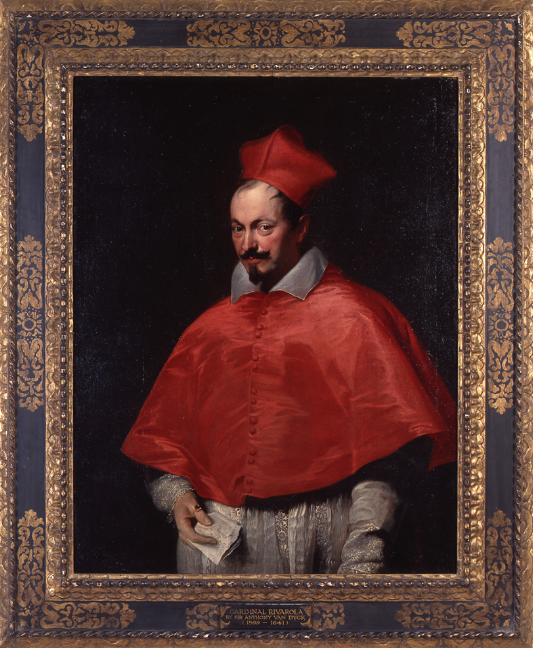
Like every other painting we’ve talked about, Van Dyck’s portrait is a religious artwork – that is, its subject is a man of the church. But both Rivarola and Van Dyck are far more interested in temporal than eternal realities. The cardinal was about 49 at the time of his sitting, and although by his fit and ruddy look here he may not have known it, his time in this vale of tears was running short. He would die in 1527, at the age of 52. Rivarola wasn’t one of the Church’s highest rollers, but he was powerful enough. He was one of 50 voting members of the 1621 conclave that elected the elderly Gregory XV pope as a compromise candidate. Two years later he was part of the conclave that elected Urban VIII. Rivarola knew power, and he used it.
As Van Dyck painted him, the cardinal is a close-vested man. He’s a calculator, an intelligence, a judge, a giver and taker of favors. He’s a man who wields power, and revels in its privileges and possibilities. He’s not a bad man, necessarily – in fact, probably not. But he’s willing to make decisions that can harm some people as they help others. In other words, he’s a politician. He’s no St. Lawrence, easing the travails of the poor. This painting is less of a holy man than of a man of power. He is the Church as an economic and political engine. The Church that keeps things running.
And here, finally, we are entering something we can reasonably call the modern age. Rivarola’s like a powerful member of the Politburo in the twilight of the Soviet era. He might be a member of the Communist party. But he’d also be a canny pragmatist, fully capable of adapting to the pragmatic challenges of a post-Communist world. A little more ruthless, and he could be Putin. The cardinal is a man of this world, not the next. Maybe he believes in the story of the Madonna, and the Cross, and the miracles. Probably he does. But they’re not the point, are they? The point is here and now. Less than a century and a half after our beginning, in the art and the society itself, it’s a new world. The ritual of Heaven-guided stability is over. Time to get things on the move. The cardinal’s clothing might say, man of God. But his face says, man.